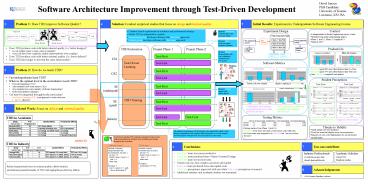Software Architecture Improvement through Test-Driven Development - PowerPoint PPT Presentation
Title:
Software Architecture Improvement through Test-Driven Development
Description:
David Janzen PhD Candidate University of Kansas Lawrence, KS USA Software Architecture Improvement through Test-Driven Development Problem 1: Does TDD improve ... – PowerPoint PPT presentation
Number of Views:100
Avg rating:3.0/5.0
Title: Software Architecture Improvement through Test-Driven Development
1
David Janzen PhD Candidate University of
Kansas Lawrence, KS USA
Software Architecture Improvement through
Test-Driven Development
Problem 1 Does TDD improve Software Quality?
Solution Conduct empirical studies that focus
on design and internal quality
Initial Results Experiment in Undergraduate
Software Engineering Course
4
1
5
Experiment Design
Context
- Conduct formal experiments in academic and
professional settings. - Isolate TDD as independent variable.
- Experiment group develops software with
Test-First approach. - Control group develops software with Test-Last
approach.
Measure productivity with total hours and hours
per feature.
- Undergraduate Software Engineering survey course
- Semester-long team programming project
- Phase 1 text UI, Phase 2 Graphical UI
- Summer 2005
HTML Pretty Print Project
Iterative Test-First
Iterative Test-Last
Pre-experiment survey
TDD Training
Post-experiment survey
Team 1 Test-First
Measure reuse From one phase/ Iteration to
another.
vs.
Team 2 No-Tests
TDD Instruction
Project Phase 1
Project Phase 2
Team 3 Test-Last
- Does TDD produce code with better internal
quality (i.e. better designs)? - Is code simpler, easier to reuse, easier to
maintain? - Does code have lower complexity, smaller
classes/methods, lower coupling? - Does TDD produce code with better external
quality (i.e. fewer defects)? - Does TDD take longer to develop the same
functionality?
Productivity
Individual Profile
Individual Profile
Measure internal design quality with size,
complexity, structural, and OO metrics.
Intermediate metrics
Final metrics
Test-First
Test-Driven Learning
CS1
Test-Last
Software Metrics
Problem 2 How do we teach TDD?
2
- Test-First spent 88 less effort/feature than
No-Tests - Test-First spent 57 less effort/feature than
Test-Last - Only Test-First completed both phases
Test-First
CS2
Test-Last
- Can undergraduates learn TDD?
- Where is the optimal level in the curriculum to
teach TDD? - From the beginning (CS1)?
- After students know some basics (CS2)?
- Once students have some maturity (Software
Engineering)? - In the field (Industry training)?
- Can tests be integrated throughout the
curriculum? - Test-Driven Learning (TDL) is an approach to
teach with tests - Is TDL effective?
Student Perceptions
TDD Training
Tested code was simpler
Higher coupling in Test-First, but
Test-First
Test-Last
Test-First
SE (undergrad)
Measure external quality with defect density.
Test-Last
SE (grad)
Test-First
Related Work Focus on defects and external
quality
3
0 Information Flow indicates procedural design in
No-Tests and Test-Last teams
Code covered by tests had lower complexity and
coupling in Test-First team
Test-Last
Test-Last
Test-First
Testing Metrics
TDD in Academia
Industry
Opinions of TF improved
Opinions of TL declined
TDD
Test-First
Threats to Validity
- Testing metrics from Phase 1 (text UI)
- Test-First wrote more tests and covered more code
with tests - No-Tests team was assigned to be Test-Last but
ran out of time - for tests
- Small sample size (ten students)
- Test-First team had slightly more Java experience
- Majority of core code implemented by one
developer - on each team
All academic programmers will develop the same
application within a class. Industry programmers
will complete different projects so we will
compare Test-First projects with previous
Test-Last projects by same team.
Test-Driven Learning (TDL)
integrates automated unit-tests into
traditional pedagogical examples, thus
modeling good testing
throughout the curriculum.
DEFECTS
TDD in Industry
Conclusions
You can contribute
6
7
Traditional Example
TDL Example
include ltcassertgt int sum(int min, int max)
int sum 0 for(int iminiltmaxi)
sum i return sum int main()
assert(sum(3,7)25)
include ltiostreamgt using namespace std int
sum(int min, int max) int sum 0
for(int iminiltmaxi) sum i
return sum int main() cout ltlt sum(3,7) ltlt
endl // above should print 25
- Test-First team was more productive
- Test-First team produced more Object-Oriented
Design - Test-First team wrote more tests
- Tested code was less complex and more decoupled
- Test-Last team produced more decoupled code
- Test-First perceptions improved with use while
Test-Last perceptions worsened - Additional industry and academic studies are
warranted
Industry Professionals
Academic Scholars
- Adopt TDL
- Replicate studies
- Contribute project data
- Email djanzen_at_ku.edu
Related experiments focus on external quality
(defect density), and indicate potential benefits
of TDD with negligible productivity effects.
Acknowledgements
8
- Dr. Hossein Saiedian, advisor































